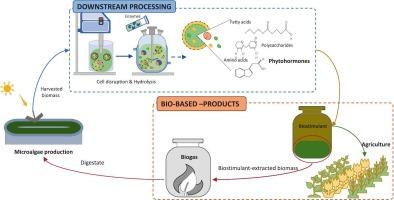用于生物刺激素和沼气生产的微藻生物炼制:资源回收的综合方法
IF 4.5
2区 生物学
Q1 BIOTECHNOLOGY & APPLIED MICROBIOLOGY
Algal Research-Biomass Biofuels and Bioproducts
Pub Date : 2025-09-22
DOI:10.1016/j.algal.2025.104323
引用次数: 0
摘要
微藻有助于解决全球挑战,包括能源、气候、资源枯竭和粮食需求。多产品生物炼制方法可以通过生产具有成本效益和有价值的生物基产品来提高盈利能力。本研究评估了在示范性回旋池中生长的Scenedesmus sp.微藻生物量产生有价值的生物产品(生物刺激素)和沼气的潜力。使用豆瓣菜、绿豆和小麦进行的生物测定证实了微藻生物质提取物的植物生物刺激素潜力,显示出与赤霉素、生长素和细胞分裂素相似的作用。中亲藻生物化学甲烷势(BMP)测试表明,从微藻生物量中提取生物刺激素可使甲烷产量增加20%(从244 mL CH4·g−1 VS增加到293 mL CH4·g−1 VS),并改善了这一过程的动力学,这是由于微藻在提取代谢物时破坏了细胞壁。这种新颖的生物精炼方法证明了有价值的生物刺激素生产和从剩余生物质中回收生物能源。这些发现为优化微藻生物精炼厂的生物量增值提供了新的见解,促进了符合循环经济原则的环境友好型和经济上可行的农业实践。本文章由计算机程序翻译,如有差异,请以英文原文为准。

Microalgae-based biorefinery for biostimulant and biogas production: An integrated approach for resource recovery
Microalgae can contribute solving global challenges, including energy, climate, resource depletion, and food demand. A multi-product biorefinery approach can enhance profitability by generating cost-effective and valuable bio-based products. This study evaluated the potential of Scenedesmus sp. microalgal biomass grown in a demonstrative raceway pond to produce valuable bioproducts (biostimulants) and biogas. Bioassays using watercress, mungbeans, and wheat confirmed the plant biostimulant potential of microalgal biomass extracts, showing effects similar to gibberellins, auxins, and cytokinins. Mesophilic biochemical methane potential (BMP) tests demonstrated that extracting biostimulants from microalgae biomass increased the methane yield by 20 % (from 244 to 293 mL CH4·g−1 VS), and improved the kinetics of the process, which was attributed to the disruption of the microalgal cell wall during metabolite extraction. This novel biorefinery approach demonstrated valuable biostimulants production and bioenergy recovery from residual biomass. These findings provide new insights to optimise the valorisation of biomass in microalgal biorefineries, fostering environmentally friendly and economically viable agricultural practices aligned with circular economy principles.
求助全文
通过发布文献求助,成功后即可免费获取论文全文。
去求助
来源期刊

Algal Research-Biomass Biofuels and Bioproducts
BIOTECHNOLOGY & APPLIED MICROBIOLOGY-
CiteScore
9.40
自引率
7.80%
发文量
332
期刊介绍:
Algal Research is an international phycology journal covering all areas of emerging technologies in algae biology, biomass production, cultivation, harvesting, extraction, bioproducts, biorefinery, engineering, and econometrics. Algae is defined to include cyanobacteria, microalgae, and protists and symbionts of interest in biotechnology. The journal publishes original research and reviews for the following scope: algal biology, including but not exclusive to: phylogeny, biodiversity, molecular traits, metabolic regulation, and genetic engineering, algal cultivation, e.g. phototrophic systems, heterotrophic systems, and mixotrophic systems, algal harvesting and extraction systems, biotechnology to convert algal biomass and components into biofuels and bioproducts, e.g., nutraceuticals, pharmaceuticals, animal feed, plastics, etc. algal products and their economic assessment
 求助内容:
求助内容: 应助结果提醒方式:
应助结果提醒方式:


